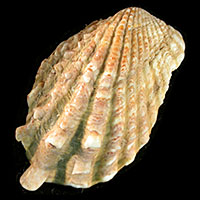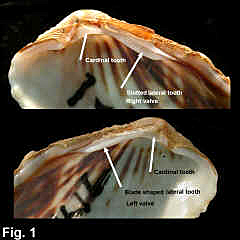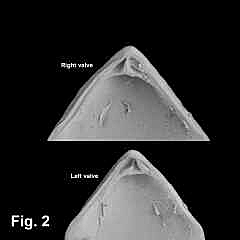|
< Previous family introduction |
|
|||||
 |
Family Carditidae Carditas
|
|||||
|
The Carditidae is represented in NSW by two distinct subfamilies. The Carditinae is a worldwide subfamily of about 140 species, small to large in size, with solid shells that are strongly radially ribbed. Some species live on rocky shores attached by a byssus, but the majority live subtidally in sand or mud. The second subfamily, Cuninae, consists of minute shells, generally less than 2 mm in size and some are even smaller than 1 mm long. There are five species of the subfamily Carditinae found in NSW. One species, Cardita aviculina, is found on rocky shores where it is attached by a byssus in crevices and under stones. This species occurs throughout southern Australia, but is unusual in reaching up the WA coast as far as North West Cape. The four other NSW species occur subtidally, in the depth range 50-300 m and, like Cardita aviculina, appear to be endemic to Australia. The subfamily Cuninae was previously placed in the Condylocardiidae, but recent genetic work has placed it in Carditidae. Shells of Cuninae are minute, and consequently live specimens are rarely collected. Most species are known only from shells, usually collected from beach washup, and less commonly sorted from dredge samples. This subfamily has recently been revised by Peter Middelfart, who recognised 33 species in Australia, 14 of which are known from NSW. Australia appears to be richer than other continents in cunine species; for example, there are seven species reported from New Zealand, with only one each reported from South Africa and South America. Family References The subfamily Carditinae is treated in Lamprell & Whitehead’s Bivalves of Australia Vol. 1 and continued in Lamprell & Healy’s Bivalves of Australia Vol. 2. The Cuninae are described in detail in:
Coverage All the NSW species of both subfamilies are treated here. Identification Notes Carditinae Shell Form: Strong, solid shells with strong radial ribs. Except for Cardita aviculina, shells are roughly circular or oval with the umbo located forward of centre. Hinge: The hinge is strong, with one or two cardinal teeth. There are two short cardinal teeth in each valve plus a single long lateral tooth (Fig. 1) that is blade-shaped in the left valve and slotted to match in the right valve. Shell interior: There are two circular or oval muscle scars. The pallial line is continuous without a pallial sinus. The margin is strongly denticulate. Cuninae Shell form: Minute shells generally with commarginal or radial sculpture, but one NSW species is smooth. The larval shell (termed the prodissoconch and best shown in the illustrations for Condylocuna projecta and Cuna concentrica) has very different sculpture to the adult shell and may be variously sculptured, such as with radial or concentric ridges. It is marked off from the adult shell by a rim or ridge. Hinge: The hinge is strong, with a large triangular cardinal tooth in the right valve (Fig. 2) and matching sockets in the left valve. Shell interior: There are two muscle scars and a continuous pallial line, but these features are usually not visible, even in electron microscope photographs. Some species have a strongly dentate inner margin, but others do not. Acknowledgement This treatment of Cuninae relies heavily on the publication by Peter Middelfart (2002). Species descriptions here are summaries of his descriptions, and the figures utilise his SEM images. The author appreciates his permission to utilise his work.
Fig. 1: 8166-1 Hinge details in Cardita aviculina. Fig. 2: 8167-1 Hinge details in Cuna concentrica.
|

